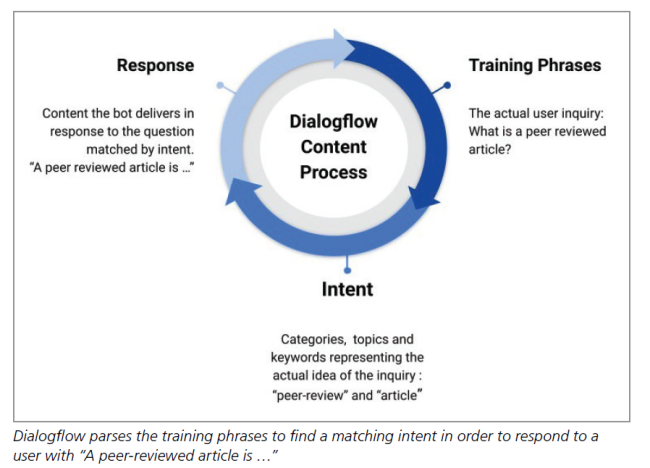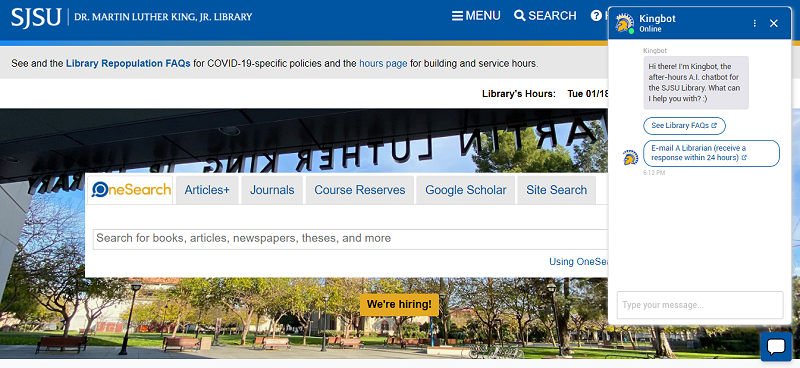|
|
|
|
FEATURE
LIBRARY CHATBOTS: Easier Than You Think
by Sharesly Rodriguez and Christina Mune
| [T]wo library and information science (LIS) virtual interns at San Jose State University (SJSU) built Kingbot, an AI chatbot … , with limited technical knowledge or coding ability. |
Academic libraries have been experimenting with chatbots for more than a decade. The University of Nebraska–Lincoln built a library chatbot, Pixel, in 2010. The University of California–Irvine built its bot, ANTswers, in 2013. Both found success in their bot-to-patron communication, but they were limited in their ability to learn from interactions and failed to provide a viable alternative to human chat interactions (Allison 2013 and Kane 2016). With the widespread adoption of AI and natural language processing (NLP) by many bot developers, chatbots are increasingly capable of handling complex information queries. As academic libraries seek to find relief from increased virtual reference traffic during COVID-19 and to develop ways to better assist patrons without expanding staffing hours, chatbots have emerged as a solution. However, the high cost of chatbot subscriptions can be daunting to libraries. In 2018, using the free chatbot platform Dialogflow and the low-cost publishing platform Kommunicate, two library and information science (LIS) virtual interns at San Jose State University (SJSU) built Kingbot, an AI chatbot that utilizes NLP, with limited technical knowledge or coding ability.
Kingbot
Kingbot is named after SJSU’s Dr. Martin Luther King Jr. Library. It is an interactive chatbot that uses NLP to answer basic circulation and introductory reference questions. It was originally intended to answer basic reference questions after librarian reference hours were over, as an alternative to consortial chat services. In 2020, Kingbot was further developed by SJSU’s user experience (UX) librarian in response to the COVID-19 crisis and the resultant increased virtual reference traffic. Due to the pandemic, there was an urgent need to provide users with immediate, current updates about the availability of library resources and spaces and to increase virtual engagement with students and faculty members. The bot was piloted in late summer/early fall 2020 and fully deployed during the fall 2020 academic term.
 Kingbot is currently available from King Library’s proactive chat widget located throughout the website. It is active during all non-staffed hours. It addresses basic circulation and reference questions and provides helpful links to libguides or other research resources. Kingbot creates an opportunity for patrons to engage with the library in a low-stress, anonymous fashion. It enables patrons to access help 24 hours a day in a virtual environment optimized for mobile devices, which was especially important during a period when students were unable to visit the library and may have had limited access to technology. Kingbot is currently available from King Library’s proactive chat widget located throughout the website. It is active during all non-staffed hours. It addresses basic circulation and reference questions and provides helpful links to libguides or other research resources. Kingbot creates an opportunity for patrons to engage with the library in a low-stress, anonymous fashion. It enables patrons to access help 24 hours a day in a virtual environment optimized for mobile devices, which was especially important during a period when students were unable to visit the library and may have had limited access to technology.
Development Tools: Dialogflow and Kommunicate
Dialogflow
Kingbot was created with Google’s Dialogflow, chatbot development software that requires minimal technical knowledge or coding skill. This is one of many open source or free development platforms available. Microsoft Bot Framework, Wit.ai, and Rasa Stack represent open source options; IBM’s Watson and Chatfuel are popular free proprietary development platforms. Dialogflow is a free platform and is one of the most user-friendly. It also has Google’s Cloud infrastructure behind it.
In Dialogflow, developers define user questions and chatbot responses to each inquiry. It has an online editor for adding or removing content. For a basic library chatbot designed to answer information inquiries and connect users to resources or library staffers, such as Kingbot, only three elements are required: training phrases, responses, and intents.
“Training phrases” are the questions, inquiries, responses, or keywords that users enter into the text field of the chatbot during interactions. “Responses” are the text the chatbot uses to respond to those training phrases. “Intents” signify the mappings between a user’s question and the response or action of the chatbot. The user asks a question, the question triggers an intent, and the chatbot offers a response. The interaction of these elements is illustrated in the image below.
Kommunicate
Chatbots are delivered to users through publishing platforms such as Facebook Messenger, Slack, or a website. To publish the Dialogflow chatbot within the existing Springshare chat widget on King Library’s website, a third-party vendor was required. The library chose Kommunicate as its bot publishing support platform because of its initial low cost of $192 a year and its user interface, which could be easily customized and branded. Kommunicate better facilitated the use of interactive display elements such as live links, images, and videos. It also offers other types of rich-message options (such as forms, card or image carousels, and calendar date pickers, if desired).
To recap, Dialogflow hosts the chatbot content and works as a server, while Kommunicate provides the interface needed to run and embed an interactive chatbot on the library website. Dialogflow communicates with Kommunicate to display the chatbot as shown in the image on the right.
Building the Content and Training the Bot
Content and Conversational Style
In order to populate training phrases (possible user questions) and responses (chatbot replies), the development team reviewed content from King Library’s LibAnswers FAQ page, chat reference and circulation desk transcripts, reference emails, and website analytics. When creating content and deciding on a conversational style for Kingbot, the library adopted best practices, and these included the following:
- Provides greetings and has a pleasant, entertaining, and engaging personality that’s human-like (Jain, Kumar, Kota, and Patel 2018)
- Provides interactive user interface elements, such as option buttons, media content, and links (Jain, Kumar, Kota, and Patel 2018)
- If the chatbot goes off track, immediately offers escalation to an alternative, such as a contact form (Guerra 2018)
It was also recommended that chatbots not require authentication or login, so that users could have a more comfortable, anonymous experience without fear of their personal information being retained or connected to potentially sensitive information inquiries.
|
 |
UX Testing and AI Training
Once initial content was written, feedback surveys from both staffers and student assistants were gathered to further refine training phrases and responses. This was done through surveys, A/B testing, and feedback solicited during live interactions with a test bot. UX testing was done with librarians, library circulation staffers, and student assistants during the pilot stages. Testing revealed the importance of brevity in chatbot responses to avoid scrolling within the chatbot to read the beginning of each answer. It was also shown that students preferred responses and chatbot actions that required the fewest clicks to satisfy the information inquiry and get connected to a librarian. This informed the choice to offer an “Email a Librarian” link at the end of every transaction rather than ask the patron, “Was this answer helpful?” before providing contact information.
In addition, librarians and library staffers were asked to rigorously test interactions with the chatbot during the pilot phase, posing questions to Kingbot that they typically received during virtual and in-person reference service. Through this testing and a thorough review of the chatbot metadata, the UX librarian was able to compile a comprehensive database of training phrases and check the accuracy of chatbot responses. Most importantly, these interactions helped train the bot’s AI algorithm to better match intents and responses to typical user inquiries. Using Dialogflow’s training feature, back-end users can enhance this training by reviewing past interactions and mapping them to more appropriate intents and responses.
Lessons Learned
Since its production launch in September 2020, Kingbot has demonstrated that a library chatbot can be developed, tested, and deployed with minimal technical knowledge and no coding skill, at a low cost. Dialogflow now offers more interactive chatbot elements than when Kingbot was initially built, potentially removing the need for the Kommunicate support platform and its related cost.
One of the most challenging aspects of Kingbot is content maintenance. All changes in library services, hours, and contact information must be updated in Kingbot to maintain accurate responses. Dialogflow does support API integrations that might ease the burden of multiple updates; however, since content is often truncated and optimized for the small chat window, it is difficult to simply call in content from a website or FAQ.
Kingbot is currently active only during unstaffed overnight and weekend hours. However, Kingbot and similar bots could also perform virtual reference triage during busy or understaffed hours, answering basic inquiries before they get to librarians or staffers. As the bot continues to learn and we refine our user engagement strategies, this option becomes more realistic. While it is unlikely chatbots will replace staffed reference anytime soon, it is certainly a useful tool for providing 24/7 virtual reference in an increasingly online user community. |
 |
Resources
Allison, D. (2012). “Chatbots in the Library: Is It Time?” Library Hi Tech . 30(1), 95–107. doi.org/10.1108/07378831211213238.
Guerra, M. (2018). Towards Best Practices for Chatbots . Thesis, University of Victoria. Retrieved June 9, 2021, at dspace.library.uvic.ca//handle/1828/9453.
Jain, M., P. Kumar, R. Kota, and S.N. Patel. (2018). “Evaluating and Informing the Design of Chatbots.” DIS ’18: Proceedings of the 2018 Designing Interactive Systems Conference , 895–906.
Kane, D.A. (2016). “The Role of Chatbots in Teaching and Learning.” E-Learning and the Academic Library: Essays on Innovative Initiatives , 131–147. |
  Sharesly Rodriguez, M.L.I.S. [left] (sharesly.rodriguez@sjsu.edu), is the user experience (UX) librarian at San Jose State University’s Dr. Martin Luther King Jr. Library. Rodriguez first helped develop the library chatbot as an intern for the university’s iSchool and is now the chatbot administrator. Sharesly Rodriguez, M.L.I.S. [left] (sharesly.rodriguez@sjsu.edu), is the user experience (UX) librarian at San Jose State University’s Dr. Martin Luther King Jr. Library. Rodriguez first helped develop the library chatbot as an intern for the university’s iSchool and is now the chatbot administrator.
Christina Mune, M.L.I.S. [right] (christina.mune@sjsu.edu), is the associate dean of innovation and resource management at San Jose State University’s Dr. Martin Luther King Jr. Library. Mune has previously held the roles of digital initiatives librarian and library technology director. Her book, Libraries Supporting Online Learning: Practical Strategies and Best Practices, is available from ABC-CLIO.
|
|
|
|